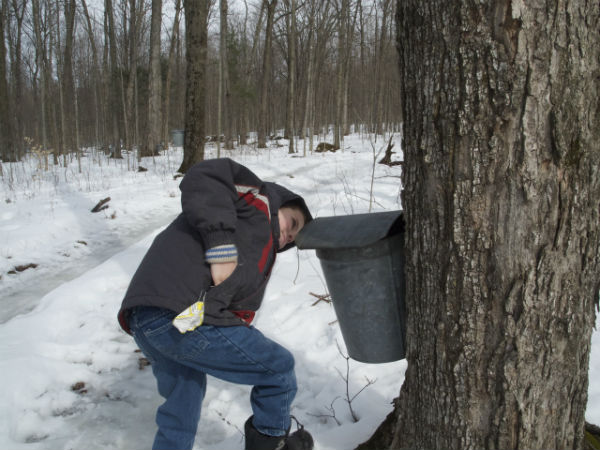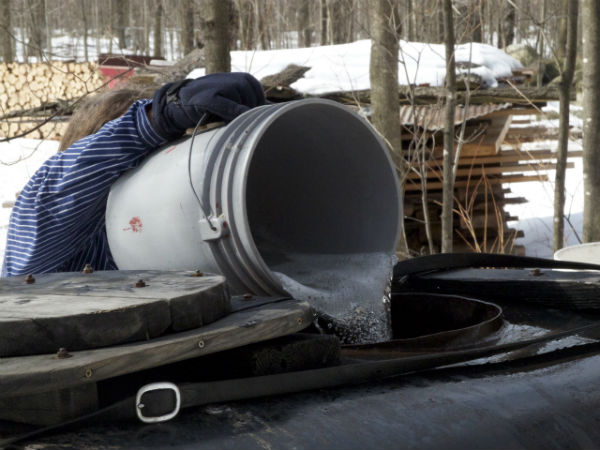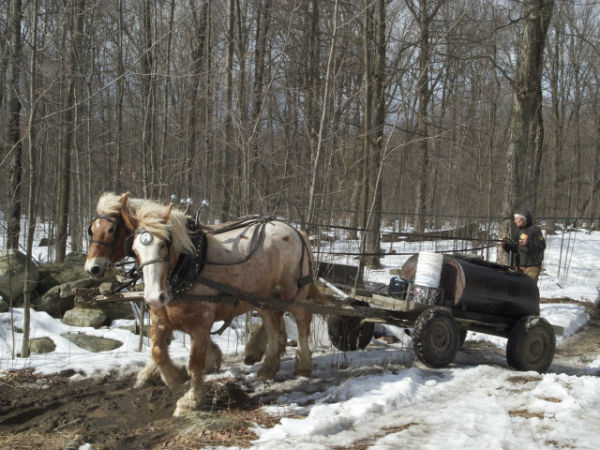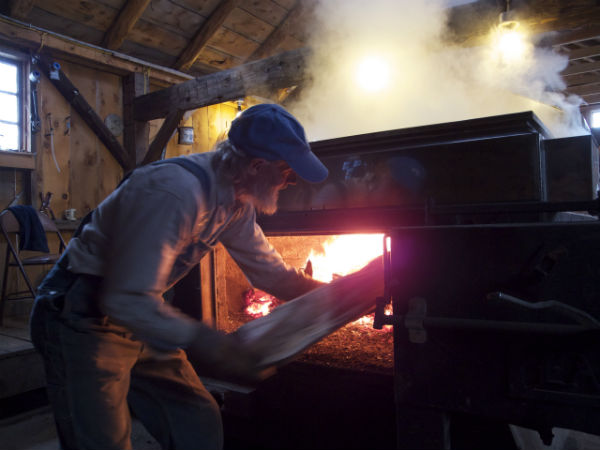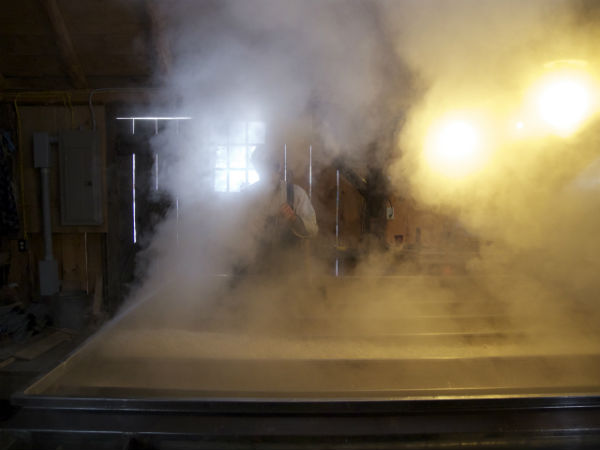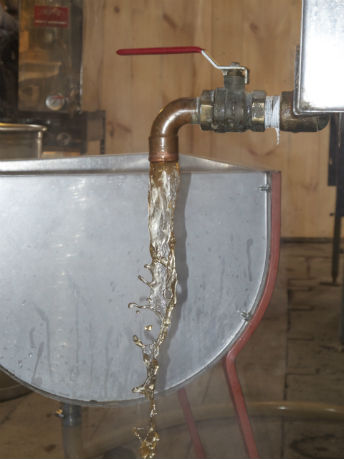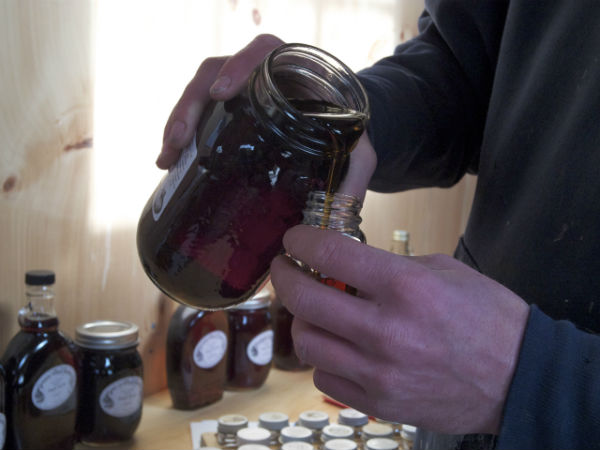Far From the Tree
Why Vermont wants you to use wine descriptors to talk about maple syrup.
The next time you take a bite of syrup-soaked pancake, ask yourself: What does that maple syrup really taste like? Do you detect a hint of spiced meat? Perhaps a whisper of mango? Or is that je ne sais quoi the flavor of oats?
If you think maple syrup always tastes like, well, maple, think again. This humble sweetener, born in backwoods cabins, has entered the highbrow world of gourmet food. Its flavor has been dissected like that of a fine wine, marketed as Vermont’s countryside in a bottle, and puzzled over by scientists trying to unravel the chemical complexities of taste.
It’s all part of a new campaign in Vermont to hitch maple syrup to the terroir movement that has people paying top dollar for coffee from a particular plantation in El Salvador or wine that captures the essence of the Loire Valley. The idea originated with University of Vermont anthropologist Amy Trubek, author of The Taste of Place, a book about terroir in America. Using a $45,000 grant from the U.S. Agriculture Department, she convened a group that included wine and cheese experts, a sensory scientist, maple producers, the state government’s Maple Specialist, and a Middlebury College chemist. In tasting sessions, meetings, and chemistry labs, they tried to pin down the flavors of maple syrup, and how it might connect to the Vermont landscape. The end result was a free guide the state’s agriculture department now gives sugar-makers, coaching them, essentially, to think more like wine snobs. It offers tips on tasting syrup, along with a thesaurus’ worth of adjectives to describe its flavors, ranging from “fresh butter” to “leather.”
The question of terroir isn’t purely academic; it’s economic, too. If someone will pay $42 for 12 ounces of coffee beans, what could Vermont producers get for a pint of private reserve syrup? The guides were meant to show sugar-makers a new way of talking about their product. If they thought more like connoisseurs, maybe they could persuade customers to pay more, and catch the attention of folks who hadn’t considered syrup a gourmet item.
Earlier this spring, as the see-saw of freezing nights and daytime thaws got sap pumping through maple trees, my 7-year-old son and I ventured down a muddy path to a wooden hut 10 miles south of the Canadian border. I had come to wrap my tongue around two questions: How different could different maple syrups really taste? And could they ever taste different enough to make me want to pay a premium for something I pour on my pancakes?
Seth Wolcott-MacCausland was my guide. His family owns 170 acres of woods where they’ve made maple syrup for three decades. (He’s also a friend of a friend, and I’d once hired him to do some carpentry work on my house. Vermont is a very small world.) The Wolcott-MacCauslands sell their organic, single-source Green Wind Farms syrup mostly through gourmet shops in Manhattan and Brooklyn. By coincidence, my son and I were joined that day by two Brooklynites, Tom O’Connor and Matt Pugliese, who had come to see the source of the syrup they sell on their specialty food website. O’Connor was charmed.
“It’s pretty cool,” he said as Julie Wolcott, Wolcott-MacCausland’s mother, drove a small, horse-drawn wagon through a maple grove, pausing to fill a tank on the wagon with sap from metal pails hung from the trees. “It’s still very connected to the land.”
Wolcott emptied the sap from the tank into a system of pipes leading to the sugarhouse. That’s where the sap’s hint of sugar is concentrated into syrup’s jolt of sweetness. A sugar-maker filters and boils roughly 40 gallons of watery sap to make a single gallon of syrup. Inside the building, as plumes of steam rose from the boiling sap nearby, Wolcott-MacCausland lined up 11 jars of the family syrup, each a different hue of brown.
I had an anxious feeling reminiscent of final exams. I am not a supertaster. While I can usually tell a syrah from a pinot noir, that’s about where my tongue’s discerning ability ends. When people start opining about wine, I’m always reminded of the Saturday Night Live skit where three pretentious oenophiles muse over their glasses:
“Oh, she is ambitious. Is anyone getting a bit of aftershave lotion?”
“Perhaps. And maybe a hint of snow, and electronics?”
But I had my cheat sheet: the plastic guide paid for with the federal grant, with its syrup-tasting tips and 43 adjectives. Among the suggested descriptors were baked apple, brioche, condensed milk, caramel, mushroom, hay, and soy sauce.
The syrup we had assembled ranged in color from honey to coffee. Lighter syrup, which is prized by sugar-makers for its color and more delicate flavor, comes from sap drawn early in the sugaring season. Late-season syrup is darker thanks to the bacteria, fungi, and yeasts that live in the plumbing that carries sap to the sugarhouse. These organisms break the syrup’s sucrose into fructose and glucose, the latter of which turns dark brown when heated. The palest syrup is labeled “Vermont Fancy.” Then comes the darker “Grade A Medium Amber” and “Grade A Dark Amber,”’ followed by the darkest, “Grade B.” Flavor usually corresponds with color: The darker the color, the stronger the flavor. But it quickly became apparent that was a crude generalization.
We started with the Grade Bs. Wolcott-MacCausland poured a small puddle from a jar into my spoon. It smelled strongly of caramel. I sipped it, willing my taste buds to reach new levels of sensitivity. There was maple, caramel, and something heavier. Chocolate? Molasses? As we worked our way through the Bs, each tasted slightly different. But we were often at a loss for the right word.
I took some comfort from the thought of Molly Costanza-Robinson, an environmental chemist at Middlebury, whom I had talked to before visiting the Wolcott-MacCauslands’ sugarhouse. She had joined Trubek’s maple terroir project, thinking it could spawn fun research for her classes. She, too, struggled during the tasting sessions, but she learned that people can nearly always distinguish between syrups, even if they can’t articulate the difference.
When I first moved to Vermont, I decided I was a Grade B man. I liked the heavier flavor, which reminded me of a cup of dark-roast coffee. But in the sugarhouse, my first spoonful of Grade A changed my mind. It was almost refreshing. The maple flavor shone more clearly. On the fifth bottle of Grade A, I found my favorite flavor, one I could describe clearly: maple accented by toasted nuts. (My son, now drunk on syrup, tipped his head back, smiled, and declared, ”Toasty. Way toasty.”)
To understand why maple syrups can taste so different, consider this: The flavor we call “maple” turns out to be a jumble of more than 150 chemical compounds. Besides the sugars, there are traces of amino acids and other acids found in wood. Their levels fluctuate as the tree awakens and prepares to grow leaves. In addition to being affected by when it’s collected during the sugaring season, the taste can be tweaked by how long the sap is stored or boiled.
So, where does that leave an aspiring maple connoisseur? Here’s the challenge Trubek’s group encountered when they tried to get a handle on the terroir of maple: Maple syrup varies so much, it’s hard to know exactly what taste is going to come out of a bottle. If you think wine is tricky to pin down, with its variations from year to year and vineyard to vineyard, consider this: Even syrup with the same grade from the same sugar-maker in the same year can taste different. In maple syrup’s case, embracing terroir, that elusive taste of a place, means accepting that a single place—a single tree, even—will contain a multitude of flavors. While I’d found a favorite, I could go crazy trying to find it again. Better to accept that maple syrup is unpredictable, and enjoy the differences from bottle to bottle.
You might think that unpredictability could make the tasting guide a handy tool for discerning consumers trying to decipher the unique flavor of each bottle of syrup. But so far, there’s not much evidence sugar-makers are promoting the guide. That’s partly because many still sell a lot of their syrup to companies that blend syrups from all over to make a product with a relatively uniform taste from bottle to bottle. (Most maple syrup sold in grocery stores is blended.) Sugar-makers have also spent years training their palates to conform to the government-sanctioned grading system, not to detect whether a syrup has lingering notes of grapefruit.
But a few sugar-makers have begun targeting a more gourmet-minded clientele (and charging a few dollars more per pint) with labels that say the syrup is organic or comes from a single source. At least one is considering marketing a premium “black label” edition of what he judges to be the best syrup of the season. There must be some marketing value in the Vermont name, because Vermont-made syrups all prominently declare their provenance. But they don’t dwell on the personalities of particular vintages. How could they, when maple syrup’s flavor is so fickle?
Still, after my tasting session I’m planning to start keeping a few bottles of syrup from different local makers in my fridge. And when the mood strikes, I’ll get a spoon and see what I can taste. Vanilla? Coffee? Electronics?
